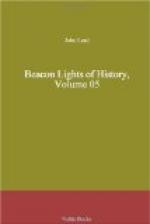On the return of Thomas to Paris he was made doctor of theology, at the same time with Bonaventura the Franciscan, called “the seraphic doctor,” between whom and Thomas were intimate ties of friendship. He had now reached the highest honor that the university could bestow, which was conferred with such extraordinary ceremony that it would seem to have been a great event in Paris at that time.
His fame chiefly rests on the ablest treatise written in the Middle Ages,—the “Summa Theologica,”—in which all the great questions in theology and philosophy are minutely discussed, in the most exhaustive manner. He took the side of the Realists, his object being to uphold Saint Augustine. He was more a Platonist in his spirit than an Aristotelian, although he was indebted to Aristotle for his method. He appealed to both reason and authority. He presented the Christian religion in a scientific form. His book is an assimilation of all that is precious in the thinking of the Church. If he learned many things at Paris, Cologne, and Naples, he was also educated by Chrysostom, by Augustine, and Ambrose. “It is impossible,” says Cardinal Newman, and no authority is higher than his, “to read the Catena of Saint Thomas without being struck by the masterly skill with which he put it together. A learning of the highest kind,—not mere literary book knowledge which may have supplied the place of indexes and tables in ages destitute of these helps, and when they had to be read in unarranged and fragmentary manuscripts, but a thorough acquaintance with the whole range of ecclesiastical antiquity, so as to be able to bring the substance of all that had been written on any point to bear upon the text which involved it,—a familiarity with the style of each writer so as to compress in a few words the pith of the whole page, and a power of clear and orderly arrangement in this mass of knowledge, are qualities which make this Catena nearly perfect as an interpretation of Patristic literature.” Dr. Vaughan, in eulogistic language, says: “The ‘Summa Theologica’ may be likened to one of the great cathedrals of the Middle Ages, infinite in detail but massive in the grouping of pillars and arches, forming a complete unity that must have taxed the brain of the architect to its greatest extent. But greater as work of intellect is this digest of all theological richness for one thousand years, in which the thread of discourse is never lost sight of, but winds through a labyrinth of important discussions and digressions, all bearing on the fundamental truths which Paul declared and Augustine systematized.”




